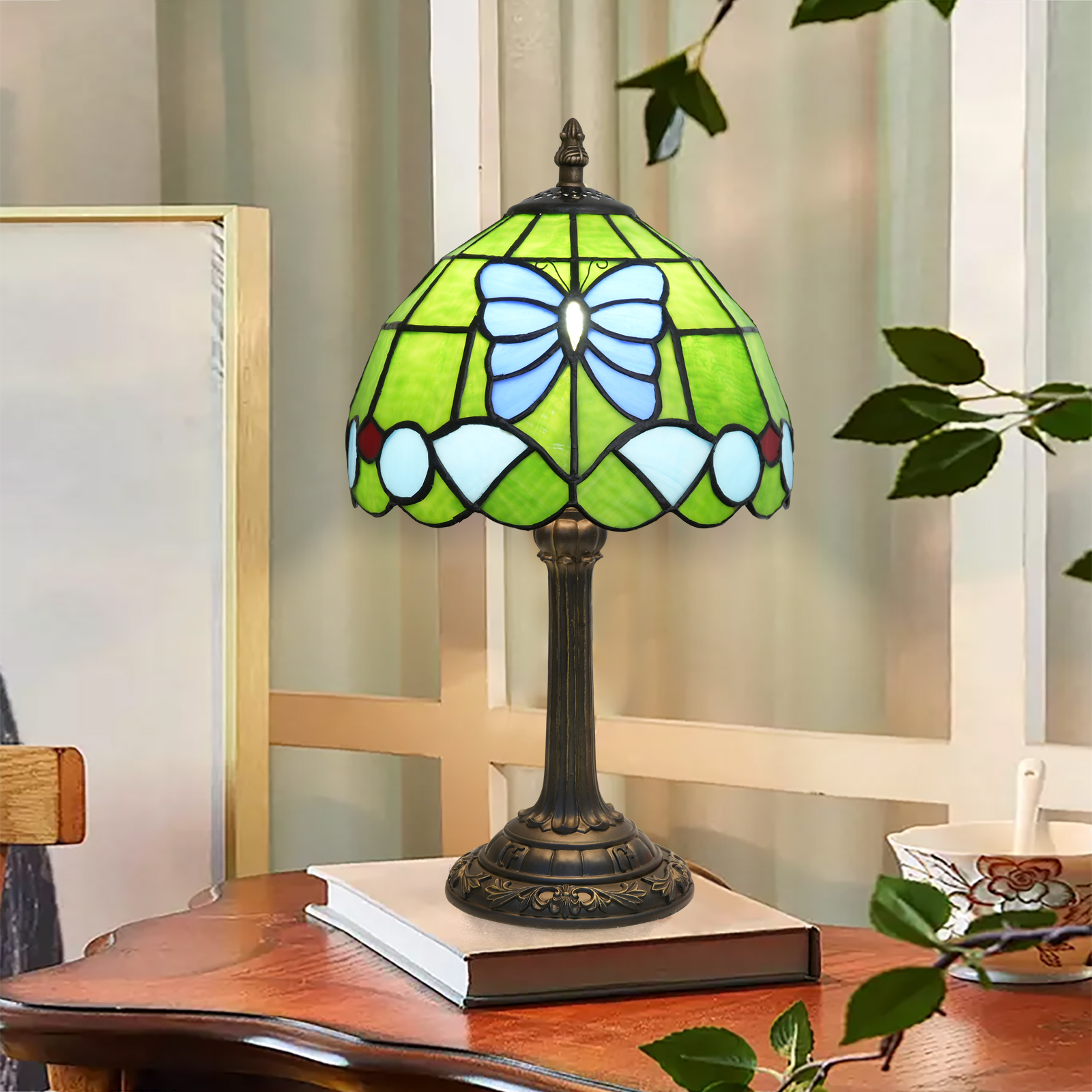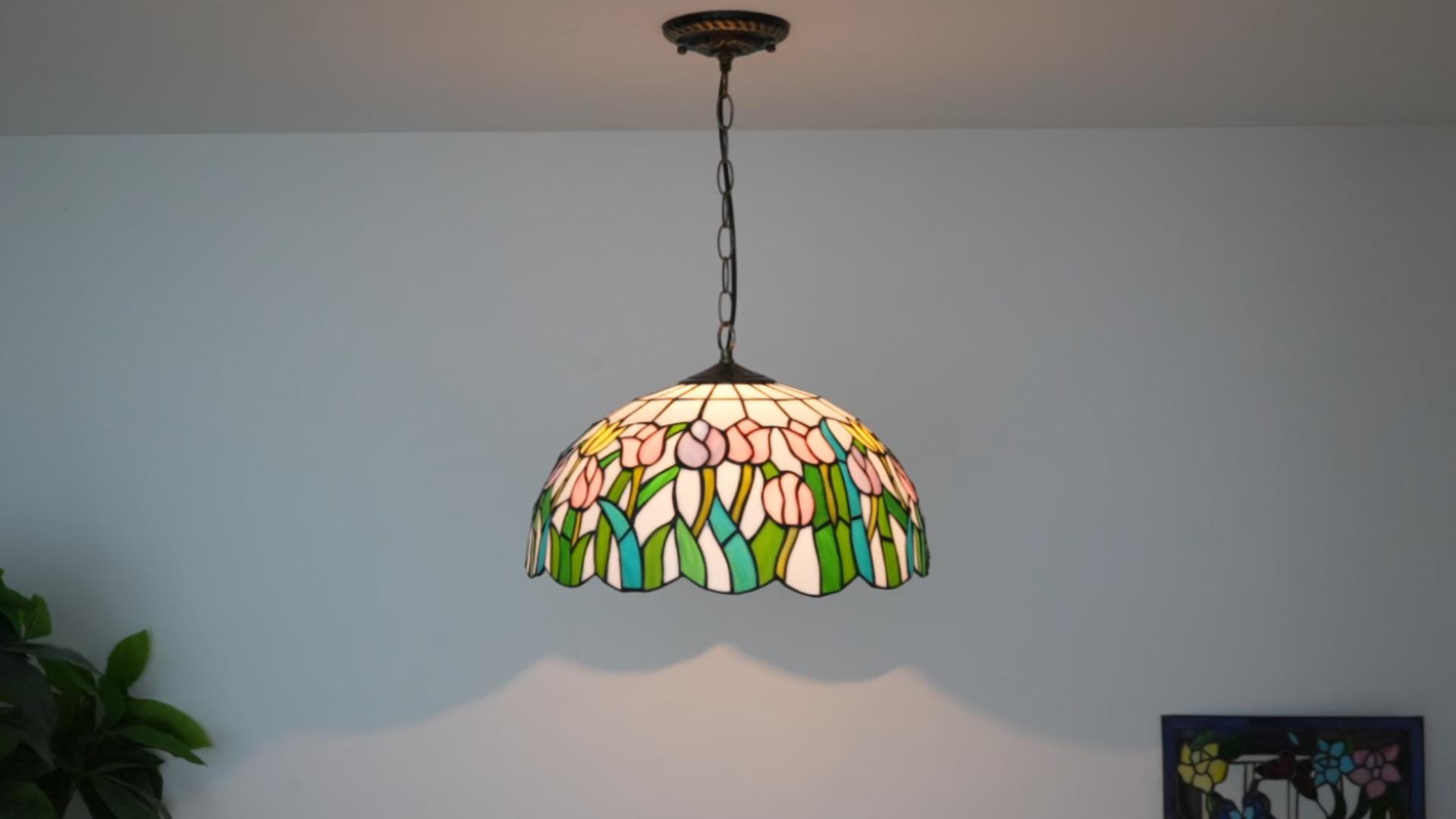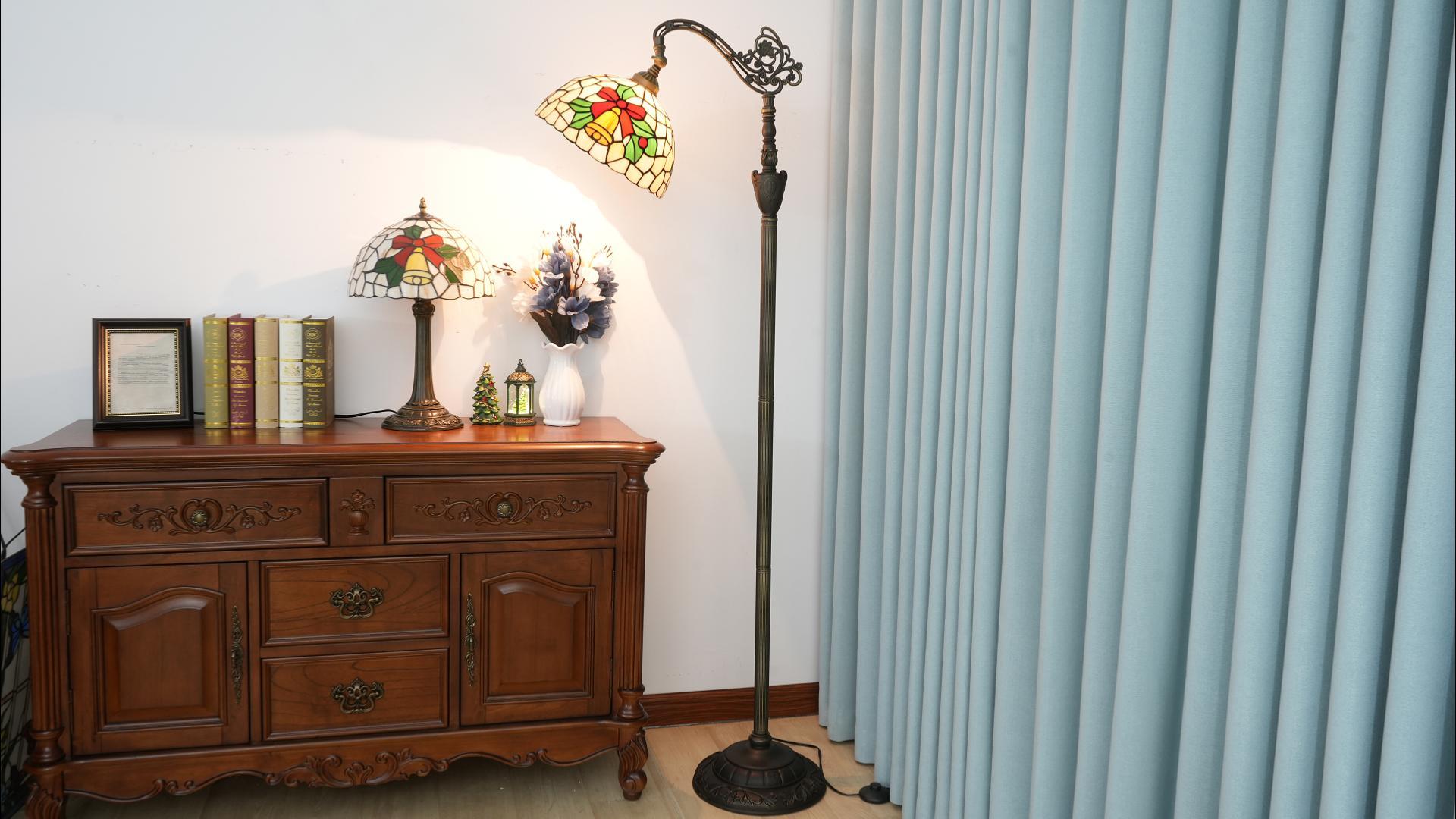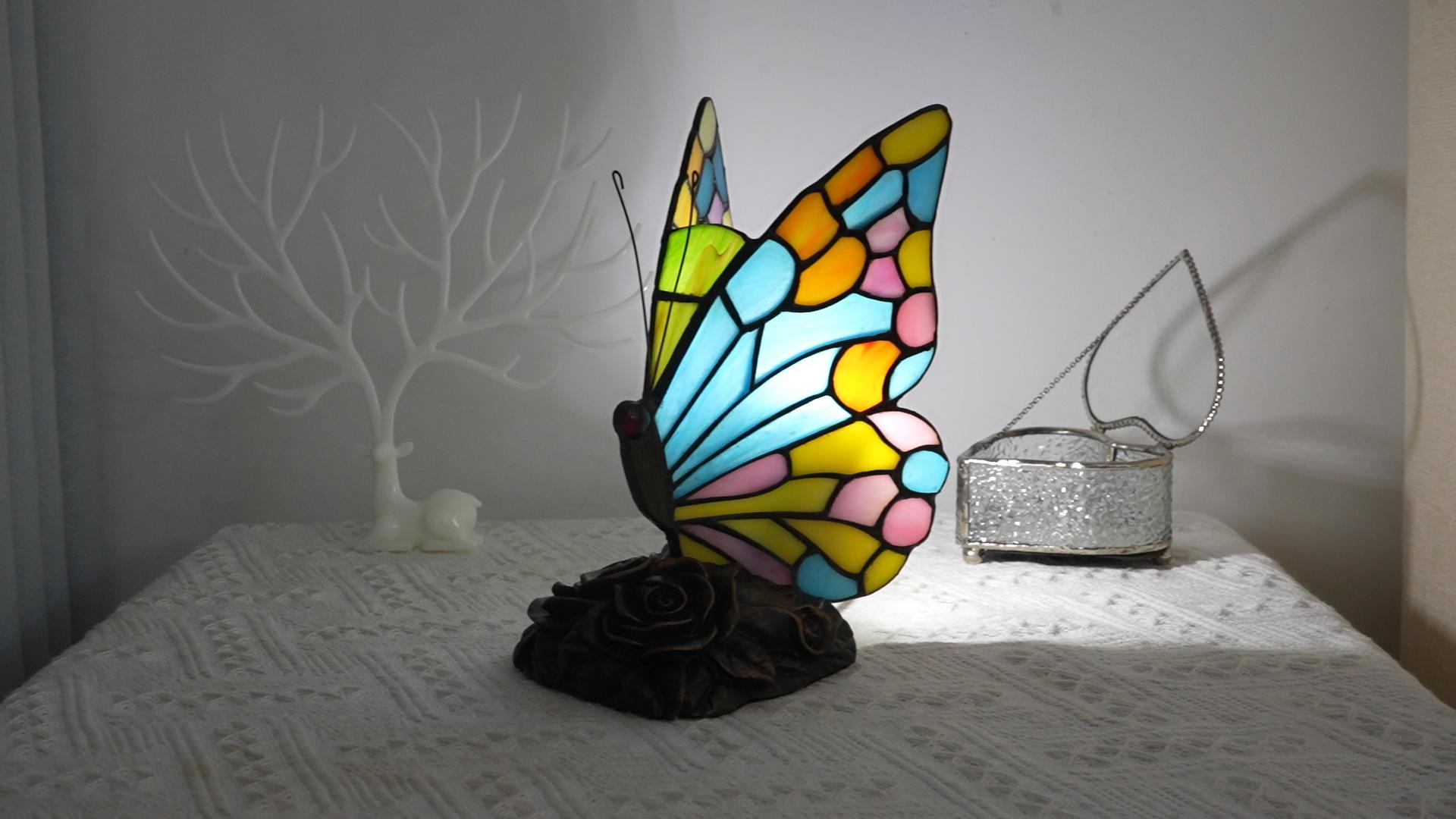When Naturalism Meets Gorgeism: 8in Handmade Colored Glass Lamp For The Century Aesthetics, Warm Reading Bed Lamp For Bedroom, Dormitory, Living Room, Dining Room And Other Retro Atmosphere Scenes


Chapter One Product Impression: The 8-inch Retro Romantic Melody
When the eyes touch this desk lamp, the first thing that catches the eye is the exquisite proportion of the 8-inch (20cm in diameter) lampshade - neither overly flamboyant and taking up space, nor lacking sufficient visual tension to become the focus. Standing gracefully at a total height of 36.5cm, with a solid base diameter of 11.5cm and a wire length of 155cm, it quietly ADAPTS to various scenarios such as bedrooms, studies, and living rooms.
The core visual symbol is like a concise nature poem:
The green background is like the unfurling of new leaves in spring. The texture on the glass surface (partially made of opalescent glass) gives off a delicate luster and layers under the light, as if it were the veins of the leaves before the morning dew has dried.
The blue butterfly is the soul protagonist. Its wings are made of transparent and semi-transparent blue glass, simulating the transparent texture of a butterfly's wings. The copper foil lines of the wing veins resemble the natural texture of growth.
The red dots, like flower stamens, add a lively vitality to the green and blue main tone, which echoes the "detail carnival" of the Victorian style.
The resin material of the base is treated with an antique copper aging process, engraved with scroll patterns and geometric reliefs. Each pattern replicates the decorative code of the Victorian era in the 19th century - luxurious, symmetrical, and full of metaphors for nature.
Chapter Two: Design Origin: A Time-Space Dialogue between Tiffany and Victoria
2.1 Tiffany Style: A Naturalistic revolution of Light and Shadow
At the end of the 19th century, Louis Comfort Tiffany, under the banner of the "Art Nouveau Movement", broke the coldness of the industrial age and regarded nature as his Muse. The colored glass lamp he pioneered takes "the gem-like halo of glass" as its core - by integrating metal oxides (such as copper, cobalt, and iron) into the glass, it creates a myriad of colors. It also uses the Copper Foil Technique instead of traditional lead strips, allowing the details of the patterns to break through the "rough framework" and move towards liveliness (such as the slender lines of butterfly wings and veins).
The blue butterfly on the green background of this desk lamp is a modern echo of Tiffany's naturalism: the butterfly symbolizes transformation and beauty, and green represents the rhythm of life. The combination of the two continues the design philosophy of "putting nature in the lampshade".
2.2 Victorian Style: A Footnote to the Era of Magnificence
During the Victorian era from 1837 to 1901, Britain witnessed an aesthetic explosion following the Industrial Revolution: the mystery of the Gothic revival, the softness of Rococo, and the novelty of Oriental elements all merged to form the design concept that "magnificence is justice". The bases of furniture and lamps must be carved with intricate patterns, and the materials preferred are bronze and solid wood, pursuing a "sense of visual abundance".
The resin base of the desk lamp pays tribute to this style with embossed scroll patterns: the curves spread like vines, the symmetrical layout conceals order, and the bronze color is aged to simulate the oxidation marks of time - although it is made of modern resin material, it precisely replicates the spiritual core of the Victorian era of "showing status through decoration".
2.3 Cross-century Integration: The Symbiosis of Nature and Splendor
Tiffany's "natural agility" combined with Victoria's "elaborate carvings" have made this lamp unique:
The lampshade is the flowing lines of Art Nouveau (butterflies, curves, color gradients);
The base is a frozen symphony of Victoria (relief, symmetry, retro color).
The two are like a dialogue between time and space, allowing a single lamp to simultaneously carry the "nature worship at the end of the 19th century" and the "magnificent revelry in the middle of the 19th century".
Chapter Three: Handicrafts: The Magic of Stained Glass Is Born
Each lamp is the result of over 30 hours of hand-polishing. Here is the disassembly of the "magic" :
3.1 Pattern Design: Precise deconstruction of Nature
The designer first hand-painted the butterfly's posture - the forking Angle of the wing veins, the opening and closing arc of the wings, and the texture direction of the green background were all repeatedly adjusted to ensure visual balance. In the final design, the butterfly is located at the center of the lampshade, the curve on the green background spreads towards the edge, and the red dots are symmetrically distributed, which coincides with the "symmetrical aesthetics" of the Victorian style.
3.2 Glass Selection: A Microscopic War of Colors
The green glass is made of "double-layer opalescent glass" : the surface layer has a hazy misty effect, while the bottom layer reveals a deep green color, simulating the light and shadow layers of leaves under the sunlight.
Blue glass is divided into "transparent blue" (wing tip) and "semi-transparent blue" (wing center). The former is like the reflection of a butterfly's wing, while the latter is like the transparency of the wing membrane. At the junction of the two pieces of glass, copper foil lines outline the tendons and bones of the wing veins.
The red dots are made of "highly saturated red glass", creating a visual contrast in the green and blue main tone, which coincides with Tiffany's preference for "color conflict".
3.3 Copper Foil Method: Millimeter-level process competition
Cutting: Use a diamond knife to cut the glass into butterfly-shaped, circular, and green-background Outlines, with an error controlled within 0.5mm to ensure a tight and seamless fit.
Edge grinding: Use a grinding wheel to smooth the edges of the glass to prevent the copper foil from being scratched or distorted by light and shadow refraction.
Foil application: Wrap the edge of the glass with 0.05mm thick pure copper foil and fix it with adhesive. The width of the copper foil (1-2mm) determines the thickness of the lines after welding (the thinner, the more it tests the craftsmanship).
Welding: On the workbench, join the glass and weld the copper foil with tin-lead alloy at 260℃. The craftsman needs to hold the lamp in the left hand and control the welding torch in the right hand to ensure that the tin flow evenly covers the copper foil and avoid tin droplets splashing and damaging the pattern.
Polishing: After welding, clean the residual flux with an acidic solution, and then polish the copper foil with a polishing cloth to give it a warm and lustrous appearance. Eventually, a texture of "glass like gemstones and copper foil like gold wires" is formed.
3.4 Base Forging: Retro camouflage of resin
Mold engraving: A Victorian style scroll pattern mold is carved in plaster, with a detail depth of 2mm to ensure the three-dimensional effect of the relief.
Resin pouring: Inject environmentally friendly resin (mixed with anti-aging agent), and cure at room temperature for 24 hours to form a solid base.
Aging treatment: First, spray a bronze-colored primer, then corrode the surface with an acidic solution to simulate metal oxidation marks, and finally apply a transparent protective paint to lock in the retro color.
Chapter Four: Decoding Materials: The Harmonious Symphony of Light and Quality
4.1 Colored Glass: The Alchemy of Light and Shadow
Composition: Silica sand as the base, mixed with metal oxides such as copper (green), cobalt (blue), and gold (red), and fired at 800℃, the color is permanently solidified (does not fade or discolor).
Feature
The "diffuse reflection" of opalescent glass: It makes the green halo softer and avoids being dazzling.
The "directional transmission" of transparent glass: making the blue butterfly present a "glowing" effect under the light;
Thickness difference (2-3mm) : Creates a sense of layering in light and shadow, such as the variation in the depth of a green background.
4.2 Copper Foil and Soldering: Connectors of Time
Pure copper foil: It has excellent flexibility and can wrap complex curves (such as butterfly wings), and copper has better oxidation resistance than lead, ensuring it does not rust for decades.
Tin-lead alloy: With a low melting point (260℃), it has good fluidity. After welding, it forms a solid "metal mesh" that supports the glass structure. Meanwhile, the luster of tin echoes the copper foil, enhancing the retro feel.
4.3 Resin base: A lightweight and elegant carrier
Eco-friendly resin: With a density only one-third that of metal, it not only reduces the weight of the desk lamp (making it easy to move), but also avoids the cold feeling of the metal base.
Carving advantages: The fluidity of resin allows for more complex reliefs (such as the fine wrinkles of scroll patterns), while metal carvings are limited by hardness and it is difficult to achieve the same level of detail.
Durability: The protective paint layer on the surface can resist daily friction and minor water stains, thus extending the service life.
4.4 Wires and Switches: Practical Hidden in Retro Style
The wire length is 155cm, suitable for most household socket distances. The online switch design (15cm from the plug) is ergonomic - no need to bend over, just a light touch of the fingertip can control the light and shadow, seamlessly integrating retro aesthetics with modern convenience.
Chapter Five: Light and Shadow Narrative: Illuminating the Artistic Atmosphere of Space
5.1 Static Beauty: The sculptural Feel before the dawn
When the light is off, the desk lamp is a "three-dimensional glass enamel painting" : the texture on the green background is like the undulating veins of a leaf, the gaps between the blue butterflies are like naturally grown cracks, and the relief on the base casts fine shadows under the play of light and shadow. Every detail silently tells of the warmth of craftsmanship.
5.2 Dynamic Charm: Color Fantasies after the Light Is Revealed
When warm light (2700K LED is recommended) penetrates the glass:
The green color splits into a "light green halo" (diffuse reflection zone) and a "dark green shadow" (thick glass area), as if the leaves are unfolding in the morning mist.
The blue butterfly becomes a "luminous body" : the transparent wing tips refract bright blue spots, the semi-transparent wing centers are tinted with soft indigo, and the copper foil wing veins are inlaid like gold threads in the light.
The red dots flicker like candle flames, infusing the overall color tone with warm balance.
The light and shadow are projected onto the walls or tablecloths, creating "colorful etched patterns" - green ripples, blue butterfly shadows, and red spots interwoven, resembling a natural sketch by an Impressionist painter, instantly filling the space with a sense of narrative.
5.3 Scene Adaptation: Coverage from atmosphere to functions
Bedside in the bedroom: Warm light creates a "bedtime fairy tale", light and shadow help you sleep, saying goodbye to the dazzling white light.
Study corner: Soft light is suitable for reading (illuminance about 150lux), and at the same time, it enhances work inspiration with a retro aesthetic.
Living room side table: As the "visual anchor point" of the space, visitors' eyes naturally focus, highlighting the owner's taste.
Restaurant center: Warm light filters the food in a golden color, making dining an aesthetic experience.
Chapter Six: Spatial Harmony: The Versatile Rules of Retro Aesthetics
6.1 Retro Space: An Immersive replica of the 19th Century
Matching elements: Dark wood-colored furniture (such as carved wardrobes), leather sofas, lace tablecloths, copper candlesticks;
Scene example: On the side table in the corner of the living room, a table lamp is placed side by side with a vintage gramophone and an oil painting. The green and blue light and shadow blend with the wooden tones, recreating the grand scene of the living room in the Victorian era.
6.2 Nordic-style Space: The Collision of Retro and simplicity
Matching elements: wooden furniture, white walls, cotton and linen fabrics;
Scene example: On the wooden bedside table in the bedroom, the green and blue color of the desk lamp breaks the monotony of white and becomes the "retro contrasting color" of the space, forming a cross-century echo with the naturalism of the Nordic style.
6.3 American Country Style: A harmonious blend of rural charm and splendor
Matching elements: checkered fabric, aged wooden table, dried flower decoration;
Scene example: On the aged wooden table in the restaurant, table lamps coexist with coarse earthenware and dried flower bouquets. The green background echoes the vitality of the countryside, and the blue butterflies add a luxurious detail, making the dining atmosphere more sumptuous.
6.4 Modern Minimalist Style: The finishing touch of artistic flair
Matching elements: minimalist white walls, metal side tables, geometric sculptures;
Scene example: On the metal side table in the living room, the retro design of the table lamp contrasts with the modern furniture. The green and blue light and shadow serve as the "soft footnote" of the space, neutralizing the cold and hard feeling of minimalism.
Chapter Seven: Cultural Inheritance: The Contemporary Warmth of Handicraft Art
7.1 Tiffany's Legacy: From Museums to Daily Life
The original lamp by Louis Tiffany, now housed in the Metropolitan Museum of Art in New York, has become a symbol of the Art Nouveau movement. This modern replica pays tribute to the master with the "handcrafted copper foil method" - although not a sky-high priced antique, it brings Tiffany's "glass light and shadow magic" into ordinary households.
7.2 Victoria's Aesthetic: Decoration is faith
In the Victorian era of the 19th century, decoration was a symbol of status and taste. The relief on the base of this lamp replicates the prevalence of "naturalistic sculpture" at that time (such as the scroll pattern symbolizing eternal life), allowing modern people to touch the pulse of that era when "decoration was a faith".
7.3 The Preciousness of Craftsmanship: The Gentleness against Industrialization rebellion
In today's era dominated by machine production, "Each lamp is unique" has become the most precious label:
The Angle difference of glass cutting (±0.5mm);
Tin flow marks from copper foil welding;
The aged oxidation spots on the base...
These "imperfections" are precisely the soul of craftsmanship, making each lamp "the one that belongs only to you".
Chapter 8 Maintenance Guide: Let Beauty Last Forever
8.1 Lampshade cleaning: A gentle ritual
Frequency: Once a month (to avoid dust accumulation affecting light and shadow);
Steps
Cut off the power and remove the lampshade (if it can be disassembled).
Gently wipe the glass surface with a slightly damp soft cloth (water + 1 drop of neutral detergent), avoiding the copper foil welding points (to prevent water from seeping in).
Dry immediately with a dry cloth to avoid water stains remaining.
8.2 Base Maintenance: Preservation of retro luster
Resin base
Dust it off with a dry cloth on a daily basis.
Stains can be wiped with diluted neutral detergent (1:10) and then dried with a dry cloth.
Avoid direct sunlight (to prevent resin from aging and fading).
8.3 Bulb Replacement: Safe Reset of Light and Shadow
Specification: E27 interface, recommended ≤40W LED warm light (2700K) (to avoid high temperature damaging the glass/accelerating resin aging);
Operation: After power-off, unscrew the old bulb and screw in the new one (avoid touching the glass to prevent fingerprints from remaining and affecting light transmission).
8.4 Storage and Handling: Detailed Protection for Damage Prevention
Storage: Wrap the lampshade with a soft cloth and place it in the original packaging or a custom-made cotton box to avoid squeezing. The base is wrapped separately and placed in a dry place.
Handling: Hold the connection between the base and the lampshade with both hands to avoid lifting the lampshade alone (to prevent the welding point from breaking due to force).
Chapter Nine: Collection and Gifting: Reasons to Own It
9.1 For personal Use: Bring the art gallery home
Aesthetic value: The fusion of Tiffany and Victorian styles makes the desk lamp not only a lighting tool but also a "light-up work of art", awakening the artistic cells of the space every day.
Emotional value: The warmth of handcrafting and the romance of light and shadow fill daily life with a sense of ceremony - the first ray of warm light in the morning and the last touch of tenderness in the dead of night are both poetic footnotes to life.
9.2 Gift-giving: The dual transmission of taste and intention
Target audience: Retro enthusiasts, art practitioners, housekeepers, and friends who pursue a high-quality life.
Symbolic meaning:
Butterfly = Transformation and beauty;
Green = Vitality and hope;
Handicraft = Unique cherishing.
From birthdays to weddings, from housewarming to anniversaries, this lamp has always been an emotional carrier that transcends material things.
9.3 Collection Potential: The time compound interest of craftsmanship inheritance
Scarcity: Handcrafting determines that "each one is unique", and it will be difficult to find a completely replicated identical model in the future.
Craftsmanship Inheritance: The combination of the copper foil method and Victorian engraving is a living inheritance of the century-old craftsmanship. As time goes by, its "cultural symbol" value will become increasingly prominent.
This 8-inch green-backed blue butterfly table lamp is not merely a lighting fixture; it is a symbiosis of "Tiffany's natural aesthetics" and "Victorian philosophy of magnificence", a gentle declaration of craftsmanship's confrontation with industrialization, and a proposal to integrate museum-level aesthetics into daily life. The moment you light it up, what you illuminate is not only the space, but also an aesthetic dialogue spanning a century, an encounter of the warmth of handcrafting and the magic of light and shadow.




